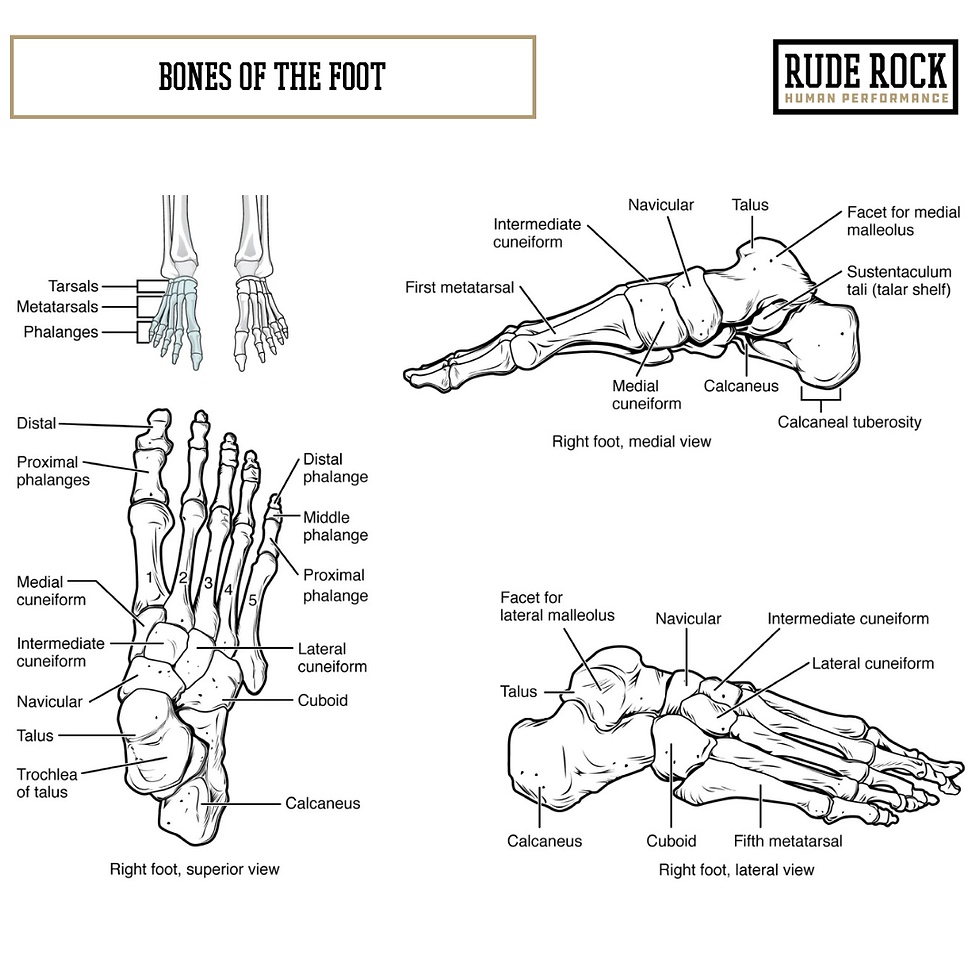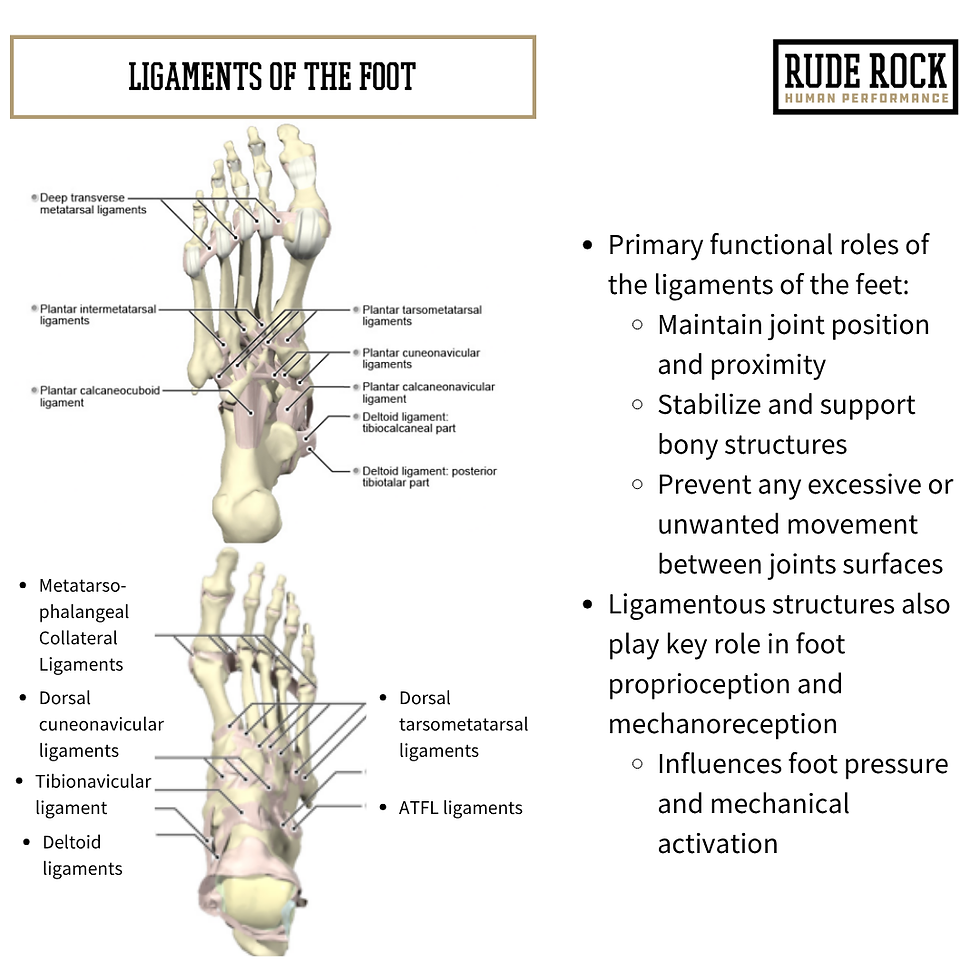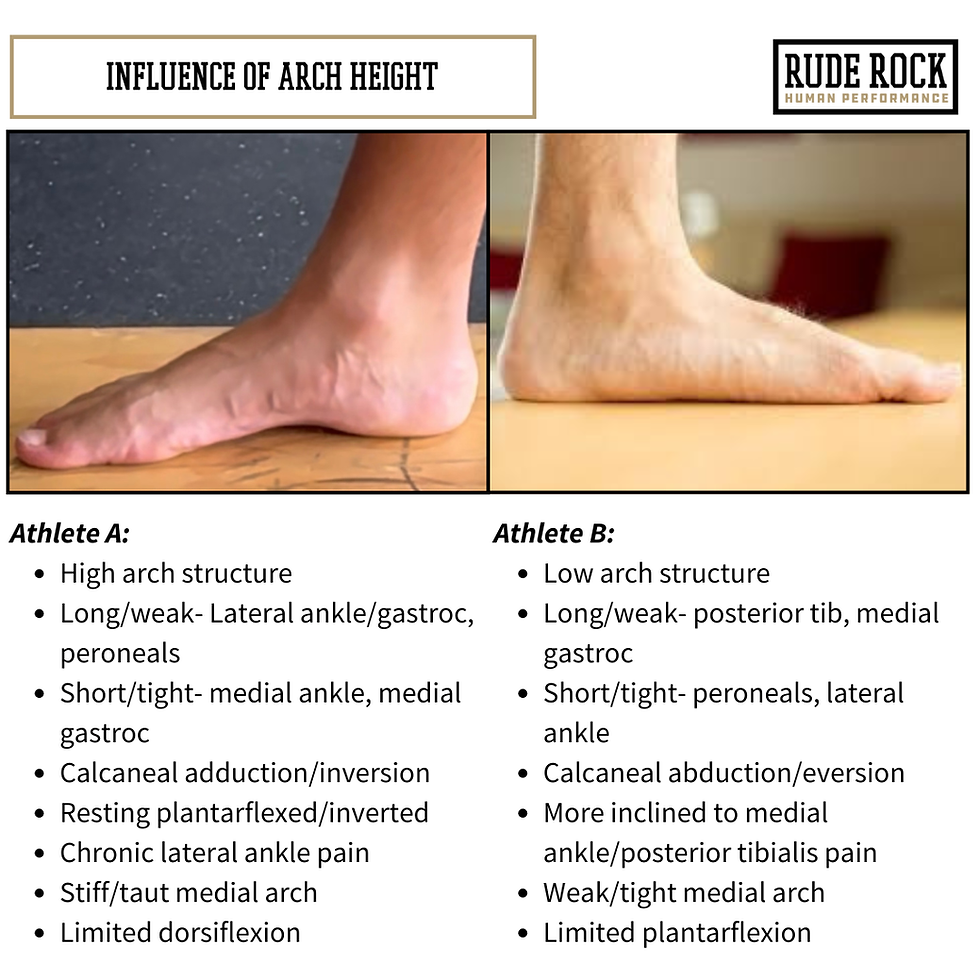The Intricacies of Loading the Foot-Ankle Complex
- Danny Foley- MS, CSCS,D*

- Oct 6
- 9 min read
Intro
Foot and ankle function is still among the most neglected, and perhaps misunderstood, components of high-performance training. The foot isn’t just some passive structure that goes along for the ride — it’s a highly dexterous, structurally refined, and integral mechanical hub for human movement. It’s the first point of contact with the ground in sprinting, change of direction, or nearly any sport-specific action. As this primary interface during ground reaction, the foot-ankle-lower leg complex is instrumental for how forces are experienced and produced throughout the body.

The foot’s design is remarkable — 26 bones, over 100 muscles, and dense networks of connective tissue and sensory receptors all crammed into a small surface area. With so many moving parts, compensations are inevitable, and those compensations carry big implications. Structure may predispose function, but it doesn’t predetermine it. No foot posture or shape is “good” or “bad” in isolation (shoutout to the GOATA clowns). What matters is adaptability: the ability of the foot to stiffen, flex, or attenuate force depending on demand (Burns et al., 2005).


There's also a clear correlation between the foot-lower leg and injury frequency and severity. Speaking from my own work experience, since working with more youth athletes over the last year, I would argue 80% of my total work demand involves foot, ankle, and lower leg injuries. With common injuries and ailments such as stress fractures, chronic ankle sprains, plantar fasciitis, and turf toe, these appear specifically problematic among youth athletes.
And to that end, I want to put more effort on sharing information and insight related to these injuries, and what we can do to reduce the frequency and severity of lower leg and foot injuries.
In this article we’ll cover:
The mechanical relationship between arch height and ankle stability
Common drivers of foot, ankle, and lower-leg impairment and injury
How body position and BOS/COM alignment change foot mechanics
Note- in case you missed it, check out this foot-ankle series I’ve been running on IG. This will also help provide some deeper context and understanding of the primary points in this article.*
Structural, Functional, and Technical Components of Foot
The SFT framework is something I adopted from Stu & ALTIS, and utilize for assessments and overall training approach. But we can also use this for an isolated view of the foot-ankle, which we'll do here.

Many coaches and practitioners get lost in “optimizing" a specific, singular quality leaving them often missing the forest for the trees. Well-meaning coaches fixate on isolated mechanics — like tibial rotation, arch height, or calcaneal position — and draw hard conclusions about injury risk or performance. And for whatever reason, this tends to occur often with the foot and lower leg- A LOT.
But watch any game for ten minutes and you’ll see a wide spectrum of shapes, positions, and patterns, and demands for the feet. Foot structure is important, but as a standalone observation doesn't give us meaningful insight on its own. Isolated testing and strength tests for the foot ankle (i.e., Natera Ankle ISO) can be greatly valuable, but again- on its own, doesn't give us much. Moreover, we can find countless examples foot position during running mechanics (check out this Gout Gout video) that defies what we believe to be facts of biomechanics. So what gives?
The key is appreciating each of the structural, functional, and technical components, and relying on your coaching acumen to determine the relative significance of each. As this applies to injury, the truth is virtually everything could be a factor, but not everything matters. For the foot-ankle complex, structural predispositions — arch shape, joint laxity, fascial stiffness, ankle mortise depth — interact with history (injury, training, sport). And combination of structural and functional factors are what predispose our coaching input for technical demands. Structural features set the groundwork, but functional and technical layers determine how that groundwork plays out under load (Hintermann, B. 1998).
An Example Between Arch Height and Ankle Stability (Structural Factors)
The shape and height of arch has historically been the villain of foot structure. Your medial longitudinal arch is a critical structure, and should be viewed as a spring — it compresses, recoils, adapts. Rather than indicting athletes for 'flat' or 'high' arches, discern the context for how this arch functions. Arch height in isolation doesn’t tell you much — what matters is the complementary foot mechanics and its adaptability under a variety of stressors.
High arches (cavus): rigid, limited pronation, poor shock absorption, lateral overload (ATFL, peroneals).
Low arches (planus): mobile, prone to collapse, medial overload (plantar fascia, tib post, spring ligament).

An important mechanical relationship with arch height is the stability of the ankle. The medial plantar arch is a primary force transmitter, and plays a massive role in how forces are attenuated and then transferred from the ground. For athletes with higher arches, the lateral ankle compartment becomes overworked as a force transmitter. Conversely, for athletes with relatively flatter arches, the medial ankle compartment and posterior tibialis can become overworked as a stabilizer and force transmitter.
Both high and low arches can contribute to risk of chronic ankle instability and balance deficits compared to “normal” arches (Zhang et al., 2023; Lin et al., 2023). There’s a mechanical sweet spot where the arch is adaptable — too flat or too rigid and you pay the price. The real goal isn’t “big arch” or “small arch.” It’s responsive modulation: the ability to stiffen when you need a lever, and yield when you need a spring. When the arch collapses, the entire foot unlocks — subtalar joint shifts, talus drops medially, tibia internally rotates — all of which compromise lateral stability and load the ATFL. Conversely, if the foot never pronates, all shock and angular demand funnel into the ankle joint, Achilles, and plantar fascia. Too much mobility or too much rigidity — either way, you’re leaking performance and inviting injury.
Quick example- Consider an athlete with extremely flat arches coupled with egregious navicular drop. This foot structure often presents with significant tonicity through the medial arch, and lateral ankle ligaments (due to increased resting eversion foot position). Inversely, with this foot structure, we’re likely going to observe tautness in the posterior tibialis (pulled at length) and potentially the lateral plantar arch.
If we don’t intervene on this, every time this athlete’s foot hits the ground (especially under high force/velocity conditions), they will continue to stiffen the medial arch and lateral ankle ligaments while concurrently putting the posterior tibialis, lateral plantar arch, and medial ankle ligaments at length. This is because the forces experienced at ground interaction will continue to transmit through the tissues that are already stiff/strong (path of greatest efficiency). These are the scenarios that lay the grounds for common overuse injuries such as plantar fasciitis, turf toe, and, in this case, medial foot stress fractures.
Common Drivers of Foot/Ankle Dysfunction
Limitations in foot ranges of motion, stability, or compliance are never just localized- the stress echoes up into knees, hips, even lumbar spine (Zhou et al., 2024).So, when it comes to injury risk, what do we really need to emphasize and understand? While no program or preventative measures can erase all risk, there are certainly strategies and applications we can adopt to reduce the probability. Here are the "big rock" criteria I've observed:
Gross ROM deficits → Limited dorsiflexion, incomplete plantarflexion and the ratio between the two is a central factor. Restricted ankle dorsiflexion drives compensation up the chain (Houck et al., 2015). Additionally, foot pronation/eversion, supination/inversion, and tibial inversion/eversion are all essential for complementing bigger actions of dorsi and plantarflexion.
Goals: Roughly 15-25° of dorsiflexion, 30-40° of plantarflexion. Approximately 1:2 ratio of DF:PF on the same foot, and less than 10° of left/right asymmetry.
Frontal/transverse mismanagement → Over-pronation (medial overload), rigid supination (lateral overload), tibial IR/ER restrictions.
Pronation and supination are very challenging to measure, and I don't personally try to collect a number for these or tibial IR/ER. However, a strong coaches eye for how these motions occur independently, and how they are integrated into global patterns should be a priority focus.
Base of Support (BOS) Relative to Center of Mass (COM) → Position determines pressure, pressure determines force
Where the foot is positioned (BOS), how it is pressurized (COP), and where it sits relative to the body’s center of mass (COM) collectively determine how forces are sequenced up the chain.

Midfoot/arch integrity → Weak posterior tibialis, poor midfoot stiffness, arch collapse under load.
When athletes lack or lose midfoot integrity, it propagates a cascade of potential aberrant patterns. Midfoot stiffness is especially critical during high velocity actions, namely at toe-off and cutting actions. The primary structure of interest here is the posterior tibialis.
Sensory/proprioceptive gaps → Loss of ground feel, reduced plantar sensitivity, slower reaction to environmental demands.
"Our ability to detect creates the opportunity to respond". Poor proprioceptive acuity at the feet, increased strain on the surrounding structures.
Incomplete or weak Windlass mechanism → Limited big toe extension, excessive tension through medial plantar arch, calcaneal instability.

The big rocks- dorsiflexion, plantarflexion, pronation/supination, and tibial rotation, all play a fundamental role for the subtalar glide and mechanics. A locked subtalar joint alters calcaneal position, which directly impacts plantar fascia, Achilles tendon, and midfoot connective tissue stress. Impairments or undue foot compensations with these patterns ultimately compromises the windlass mechanism, along with the points below on force following stiffness.
Force Follows Stiffness
A final but important consideration here is understanding how forces are transmitted and encountered at the foot. "Force follows stiffness" has been a central heuristic for how I view the onset of soft tissue injuries, particularly as it relates to addressing the foot. Force follows stiffness is something Keith Barr speaks to frequently, particularly regarding stress shielding.
Stress shielding is a mechanical phenomenon in which the body will protect or guard damaged areas by routing mechanical forces through surrounding structures. This is a protective mechanism and evolutionarily is great for our survival, but comes with consequences in the performance context. What it comes down to at the foot and ankle is recognizing the differences in stiffness across foot structures, such as the stiffness of medial vs lateral plantar arches. When we have dramatic differences in stiffness between these structures, athletes are at a disposition for creating an injury. If we don't intervene correctly on this in training, what will happen is what’s already stiff/strong will only become stiffer/stronger, and what is already compliant/weak will continue to become weaker. The greater the differences between what's strong and weak, the greater the risk for injury becomes.
We need stiffness in the foot-ankle complex, over mobilizing can be just as detrimental to foot function and health as being overly stiffened or rigid. What we need to recognize and understand is that it ultimately comes down to thresholds and proportionality between structures, not just “stiffness good, compliance bad”, or vice versa. In practice, too many programs give calves, ankles, and feet generic “heel raises” or baseless mobility drills. But the foot needs to be trained to attenuate (eccentric), stabilize (isometric), accommodate (oscillation), and produce (concentric) across angles of dorsiflexion, plantarflexion, inversion, and eversion.
Closing
The foot is a paradox: rigid yet mobile, simple at a glance but wildly complex under force. When this is neglected or ignored in training, at best we’re leaving performance progress on the table and at worst the athlete experiences recurring sprains, tendon issues, and stress fractures. Managing and monitoring overall workload (intensities, cutting, hard braking), contact times and volume, coupled with building in specific training protocols for foot and ankle mechanics is the complete solution for chronic foot pain and problems (Lin et al., 2023). The foot-ankle complex is instrumental for sport performance, and we need proficiency as a spring, brace, lever. Strong feet don’t happen by accident. They’re built — one position, one bias, one rep at a time.
References
1. Burns, J., Crosbie, J., Hunt, A., & Ouvrier, R. (2005). The effect of pes cavus on foot pain and plantar pressure. Clinical Biomechanics, 20(9), 877–882.
2. Hintermann, B., & Nigg, B. M. (1998). Pronation in runners: Implications for injuries. Sports Medicine, 26(3), 169–176.
3. Houck, J. R., et al. (2015). Effect of ankle dorsiflexion range of motion on lower extremity kinematics and kinetics during functional tasks. Journal of Athletic Training, 50(3), 311–319.
4. Lee, D. H., et al. (2016). The effects of intrinsic foot muscle strengthening exercises on medial longitudinal arch morphology and function. Physical Therapy Rehabilitation Science, 5(2), 78–85.
5. Lin, C. I., et al. (2023). Postural control in individuals with chronic ankle instability: A systematic review and meta-analysis. Journal of Sport Rehabilitation, 32(6), 572–584.
6. Mulligan, E. P., & Cook, P. G. (2013). Effect of plantarflexion and dorsiflexion wedge conditions on Achilles tendon load during gait. Journal of Orthopaedic & Sports Physical Therapy, 43(3), 167–174.
7. Zhang, S. N., et al. (2023). Effects of high-arch and flat foot deformities on postural control: A systematic review and meta-analysis. Gait & Posture, 104, 144–154.
8. Zhou, Y., et al. (2024). Acute restriction of ankle dorsiflexion alters knee and hip joint motion and neuromuscular control during squatting. Journal of Biomechanics, 160, 111049.







Comments